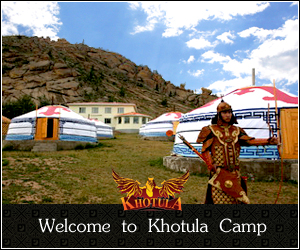Two Hump Camel
 Camels are divided into 5 types. Camels in Mongolia are of the two-humped Bactrian variety. They have traditionally been important for transport (they are used for moving gers) and status, but have been steadily reducing in numbers, perhaps because of the introduction of mechanized transport.
Camels are divided into 5 types. Camels in Mongolia are of the two-humped Bactrian variety. They have traditionally been important for transport (they are used for moving gers) and status, but have been steadily reducing in numbers, perhaps because of the introduction of mechanized transport.
Bactrian camels also live in the wild in Mongolia, but are very close to extinction — the vast majority are now domesticated. It’s estimated that there are only 1,000 left in the wild, with the main threat to their lives from habitat loss. As more towns are built up in the Mongolian desert, less watering holes are available for the camels. They are also in competition with the domesticated herds. Camels are extremely well suited to living in the desert; in the summer their coat is short and thin and in the winter it grows thick, long and dark which protects them from the cold. They can close their nostrils to keep out sand in high winds. Although their walk looks strange and swinging, they can outrun a horse — their top speed is 65 km/hr.
Although their walk looks strange and swinging, they can outrun a horse — their top speed is 65 km/hr.
They can be 3m tall and weigh up to 700kg.Camels eat mostly grass, leaves and shrubs, but they will eat thorns, dry vegetation and saltbush if they have no alternatives. Their humps are not full of water, as is commonly believed, but fatty tissue. This helps them to survive long periods where they may not be able to eat properly, and can also indicate if they are healthy — when they are properly fed their humps are plump and stand upright. If they are undernourished the hump can shrink and lean to one side. Most camels give birth in March or April, after a gestation period of 12-14 months. The calves stay with their mothers for about 1.5 years and are not fully grown until they are 5 years old. Camels can live up to around 40 years old. Camels tend to live in family groups in the wild, which consist of one male, several females and their offspring. Camels are extremely useful to the Mongolian people, as a source of wool, milk, meat and fuel as well as being able to earn great loads over long distances. It is thought that they were first domesticated around 2,000 years ago.
 Camels drink huge amounts of water at a time: up to 130 litres. This has to be raised from underground wells by hand, so to water a whole herd of camels can take several hours. Camels can survive for up to 9 days without water, which is much longer than humans, but for them to be in the best of health it should be more frequent than this. The two humped camel of Mongolia is uniquely suited to the harsh and seasonal climate of Mongolia. This camel is covered with different types of hair: coarser hair, fine-grade hair and intermediate hair. The fine-grade hair is soft to the touch, and possesses a small amount of crimp offering durability and stretch. The quality of camel wool is determined by the age and sex of the camel. Camels less than 3 years old produce very high quality wool. The wool of a camel calf and yearling camel is shorter but the tuft of hair is softer. Of the total hair from the Mongolian two-hump camel, 80% is the fine-grade hair with a diameter of 17-20 micron range.
Camels drink huge amounts of water at a time: up to 130 litres. This has to be raised from underground wells by hand, so to water a whole herd of camels can take several hours. Camels can survive for up to 9 days without water, which is much longer than humans, but for them to be in the best of health it should be more frequent than this. The two humped camel of Mongolia is uniquely suited to the harsh and seasonal climate of Mongolia. This camel is covered with different types of hair: coarser hair, fine-grade hair and intermediate hair. The fine-grade hair is soft to the touch, and possesses a small amount of crimp offering durability and stretch. The quality of camel wool is determined by the age and sex of the camel. Camels less than 3 years old produce very high quality wool. The wool of a camel calf and yearling camel is shorter but the tuft of hair is softer. Of the total hair from the Mongolian two-hump camel, 80% is the fine-grade hair with a diameter of 17-20 micron range.
The two-hump Mongolian camel wool from camels more than 3 years old, is classified as female or male wool. The female camel wool contents 60% of fine-grade fiber with diameter of 25 microns. The tuft of this wool is relatively coarse. The male wool is similar to the long, coarse hair that is found on the camel’s knee, chest and throat. Each Mongolian two-hump camel produces an average of 5 kg of hair per year. The endless hard work of the herdsmen and their families results in harvesting of 1300 tons of raw wool from over 260,000 head of two-humped camels. The two-humped camel originated and is thriving in Mongolia. This breed is rarely seen anywhere else in the world.














Could you please send information, relating to visiting and observing your camel operation. I attended the International Rangeland Conference in Hohhot last years and met with some of your camel people and was so impressed with their enterprise and the clothing they had produced from the camel hair.
Two colleagues and myself are planing a trip and would appreciate some information
Sincerely
Annabel Walsh